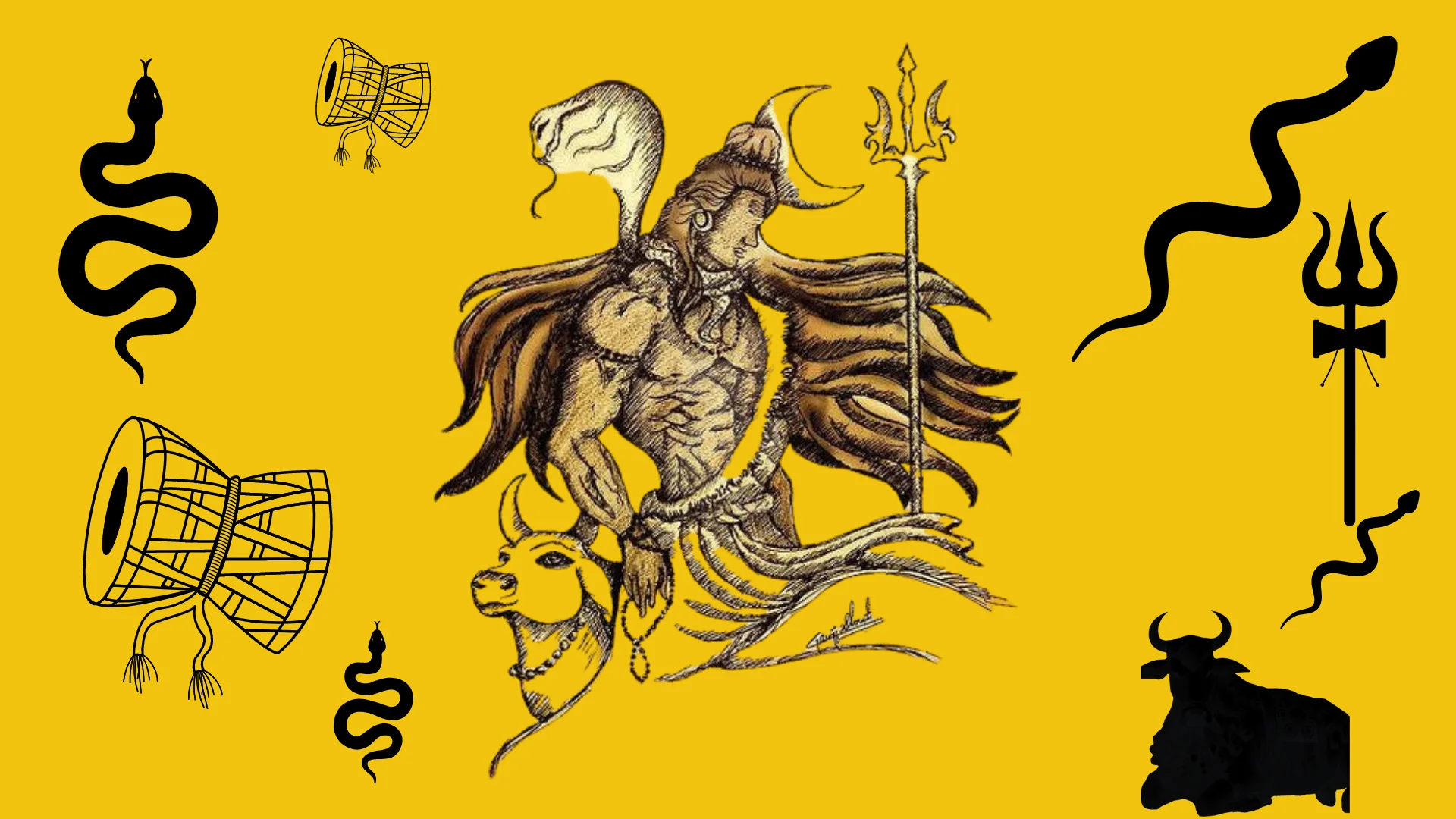The Main Highlight of Chanting Om Namo Bhagavate Rudraya
Although Lord Shiva is pleased even with a little sadhana, there are some mantras which bring instant results. One such mantra is the Om Namo Bhagavate Rudraya mantra. The mantra may look short but it does wonders. Among Lord Shiva’s forms, Rudra is very
easy to please. Chanting Om Namo Bhagavate Rudraya (some call it om namo bhagwate rudray namah) is conducive for getting promotions in jobs. It can also be chanted to boost business or start-up, attract clients and increase sales. Those who are fighting court cases gain victory.
When chanted with devotion, the sound vibration of om namo bhagwate rudray namah acts like a spiritual forcefield. It not only offers material benefits such as court victories and business growth, but also cultivates inner courage and detachment. This mantra is highly effective for those undergoing turbulent phases in life, reminding them that Lord Rudra’s grace can transform suffering into strength and clarity.
Om Namo Bhagwate Rudraay namah meaning: “Salutations to the divine Rudra, the fierce form of Lord Shiva, the one who liberates and protects the devotee with power and grace.”
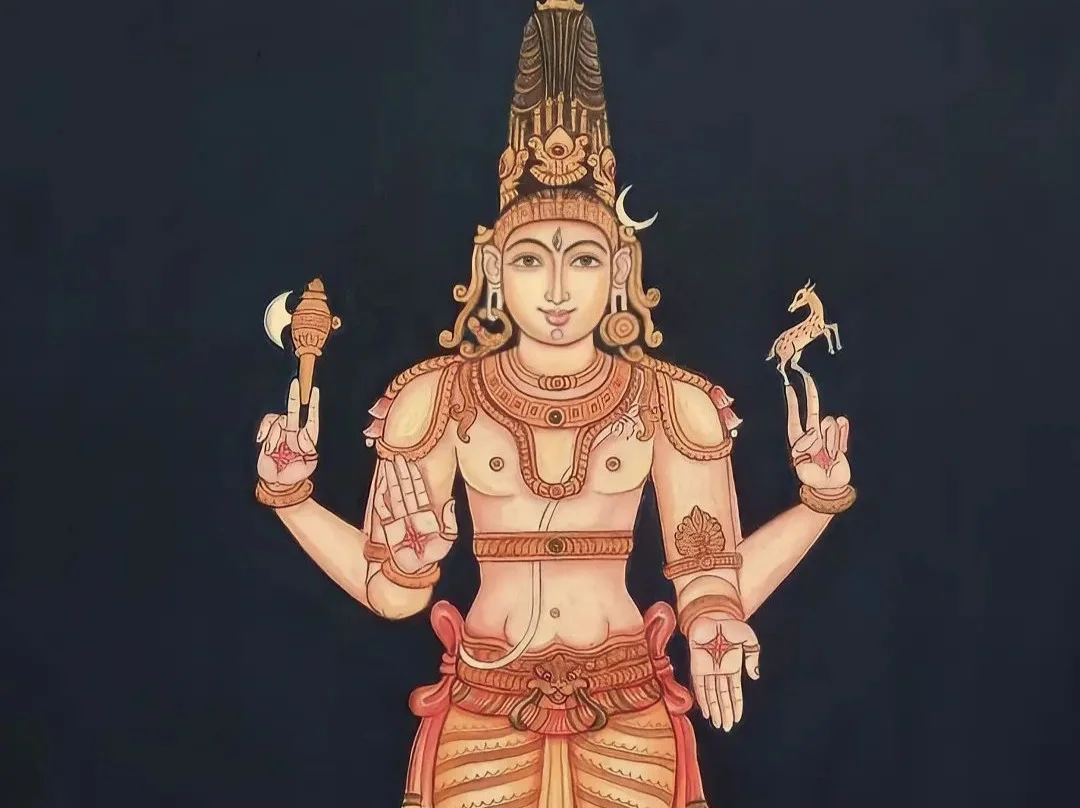
The mantra is like a wish-fulfilling tree which fulfills all legitimate desires of the chanter. It has healing powers and can cure chronic disorders. Some benefits of chanting rudra mantra are: regular practice brings strength, mental clarity, and protection from unseen dangers.Students can secure flying colours through repeated mantra chanting. This does not mean one stops studying. The mantra is ideal for dancers, as Nataraj the lord of dance is the manifestation of Rudra.
For students, artists, and seekers alike, the mantra om bhagwate rudraya namah brings focus and divine creativity. It awakens the inner Rudra, sharpening intellect and enhancing performance across fields. Especially for those struggling with self-doubt, this mantra connects one to a higher intelligence that guides and protects.
The Best Mantra for Solving Marital Issues
Couples facing marital issues will start seeing improvement in their relationship. If you are struggling to make your ends meet, then this mantra is definitely for you. Financial and Marriage problems shall cease to exist. The Shiv rudra mantra benefits emotional healing, clarity, and brings harmony in personal relationships.
Among the most profound om rudraya namah mantra benefits is its ability to cut through emotional knots. The mantra releases suppressed traumas and strengthens the energy of forgiveness between couples. It works quietly yet deeply to heal wounds that words cannot, creating a sacred vibration within the home.
Shaivites who wish to dedicate their lives in loving service to Lord Shiva develop a bond with the Lord. The only condition is that one should chant the mantra with faith and love for the deity. For those seeking to walk the path of tapasya and devotion, om rudraya namah is more than a chant—it is a surrender. This phrase, when repeated with sincerity, connects the devotee with Rudra’s raw transformative fire. It burns away arrogance and purifies the ego, making space for bhakti to flow naturally.

Note that the mantra should only be chanted under the guidance of a qualified guru. There are six syllables in the mantra similar to the Om Namaha Shivaya mantra. However the Om Namaha Shivaya mantra is subtler.
Understanding the Om Namo Bhagavate Rudraya Mantra
To understand the power of the mantra, Let us break the mantra into four parts- ‘Om’, ‘Namo’, ‘Bhagavate’, and ‘Rudraya’. The first part of the mantra is Om. Om is the cosmic sound. The positive vibrations due to Om chanting build immunity and concentration. ‘Namo’ means the act of bowing down. Chanting Namo increases humility and helps in personality development. Lord Shiva loves humble people.
If your goal is to become the eternal servant of Lord Shiva, you can chant the mantra thinking yourself to be a part of the Shiva Parivar. Imagine yourself sitting on the lap of the great lord. Invoke Lord Rudra with a heart full of love and trust. He will definitely listen to you.
The om rudraya namah meaning reminds us that to bow to Rudra is to bow to the force that dissolves illusion. Rudra is fierce because He loves fiercely. He tears away ignorance so that only truth remains. To understand this mantra is to understand the path of liberation: courageous, unyielding, and filled with divine compassion.
For this to happen, it is essential to be desireless. The mantra is like a treasure chest and the key to it is a selfless heart. If your mind is filled with greed, lust and anger, you can never assess the full potential of the mantra.

The mantra has the power to open the doors of Kailash where you will eternally serve the lord as His daughter/son. This is a proven fact. ‘Bhagavate’ addresses Lord Rudra as the Ultimate Reality. Here, this is om bhagwate rudraya namah mantra meaning: this mantra is an invocation of Lord Rudra’s energy to burn away negative karmas and uplift the soul. In this context om rudraya namah mantra benefits : protection, spiritual insight, and freedom from mental agitation.
The om namo bhagavate rudraya mantra acts as a purifier of one’s karmic baggage. It cuts through layers of confusion, making the sadhaka receptive to higher knowledge. This mantra, unlike casual affirmations, is encoded with divine intention, liberating not just the chanter, but generations before and after.
Finally ‘Rudraya’ glorifies Lord Rudra, a form of Lord Shiva. Lord Rudra destroys the universe and he is fierce by nature. The om namo bhagavate rudraaya mantra meaning: “Salutations to Rudra, the Supreme Divine, the remover of suffering and protector of devotees.” Rudraaya meaning: Rudra refers to the fierce, purifying, and protective aspect of Lord Shiva.
Chanting the om namo bhagavate rudraya namah mantra harmonizes one’s physical and astral bodies. It’s a mantra that doesn’t just cleanse the aura but also activates divine will. Many householders and sannyasis alike have experienced spiritual breakthroughs while doing sadhana with this mantra consistently for 41 days.
While chanting the mantra, it therefore becomes essential to drink lots of water, else repeated chanting of the mantra can heat up the body and damage internal organs.
A Pauranic Story about Lord Rudra
Now, I will briefly cover the story of Lord Rudra. At the start of creation, Brahma ordered the 4 Sanak kumaras to produce progeny but the brothers plainly denied his order. Brahma was enraged. His eyebrows tensed as a reflex. From the midst of his eyebrows appeared an infant who was none other than Rudra. The infant wept continuously. From the Sanskrit word Rudan which means crying, Lord Rudra got his name. Here Sri Rudra benefits the force that clears stagnation, removes fear, and revitalizes life energy.
The deeper spiritual essence of om namo bhagwate rudraay namah lies in its ability to unblock life’s gridlocks, whether emotional, financial, or karmic. By invoking this sound code, one aligns with the archetype of Rudra who doesn’t tolerate stagnation. His fierce grace demands truth, action, and inner evolution.
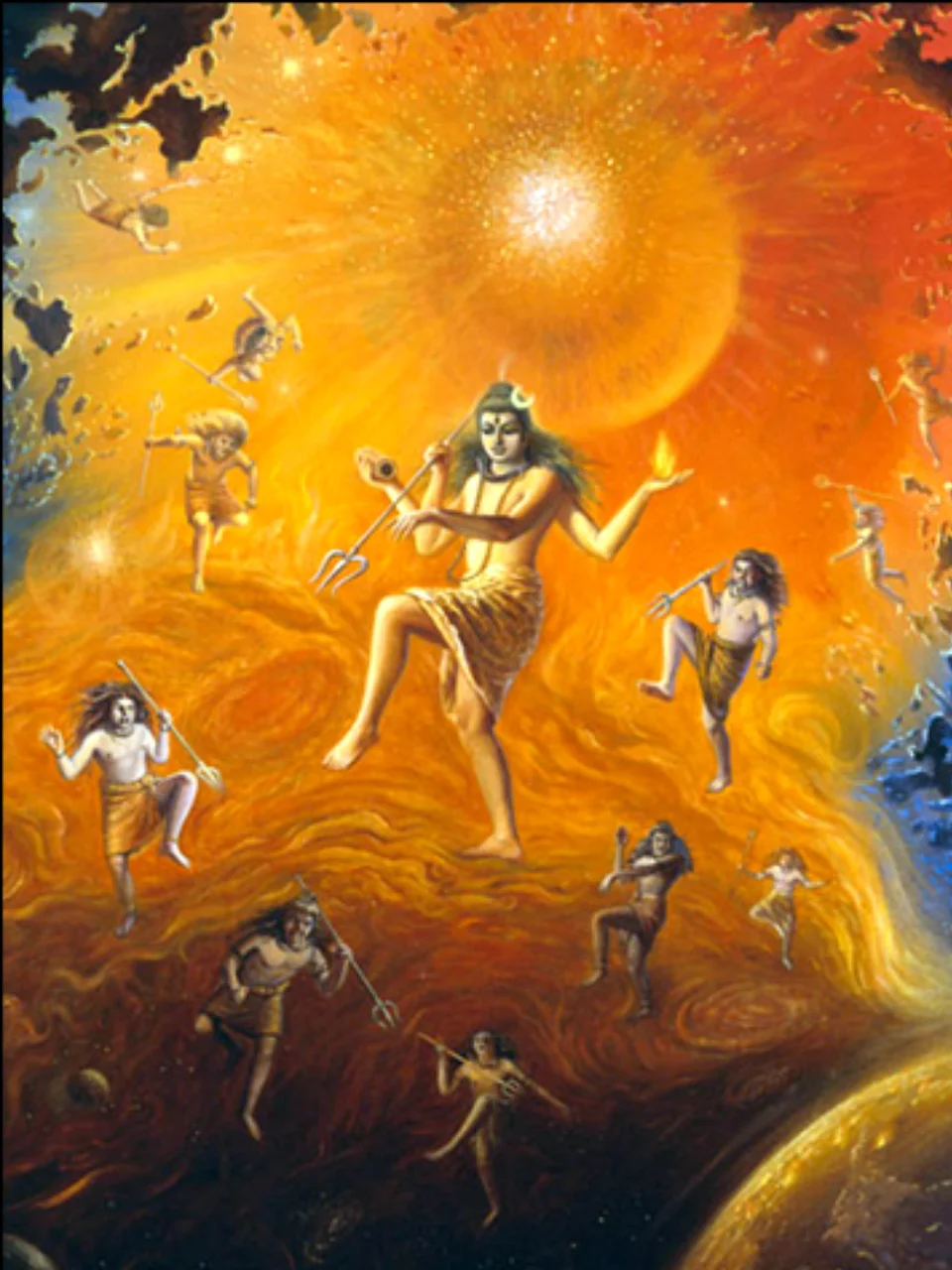
Lord Rudra resides in the senses, life force, heart, ether, wind, fire, water, earth, austerity, the moon and the sun. Now, many would want to know the difference between Shiva and Rudra. Rudra is the fierce form of Lord Shiva; he is limitless and knows no rules.
On the other hand, Lord Shiva is benevolent and has a family. He is the giver of knowledge, liberation and gets easily pleased by his devotees. He is the conqueror of death and is hence known as Mrityunjaya. Understanding om namo bhagavate rudraya mantra ke fayde helps in setting a clear spiritual intention. Not only does the mantra protect from accidents, illness, and premature death, but it also acts as a catalyst for self-transformation. These benefits are not mythological, they are time-tested by thousands of seekers through centuries.
The Rudra shiva stotram mantra benefits in english embodies chanting praises to Rudra in stotra form purifying the ego, enhancing inner strength, and bringing courage in difficult times. The om namo bhagwate rudraya mantra pairs beautifully with the Rudra Shiva Stotram. Chanting both together amplifies their effects.
While the Stotram praises multiple forms of Rudra, the mantra tunes your inner frequency to his central essence. For deep sadhana, alternating between the mantra and the stotram can lead to intuitive insights and yogic stillness. Let us cover the Rudra Shiva Stotram mantra here
The Rudra Shiva Stotram Mantra with Lyrics
Oṁ
Bhairava rudrāya, mahā rudrāya
Kāla rudrāya, kalpantara rudrāya
Vīra rudrāya, rudra rudrāya
Ghora rudrāya, aghora rudrāya
Mārtaṇḍa rudrāya, anda rudrāya
Brahmāṇḍa rudrāya, caṇḍa rudrāya
Prachaṇḍa rudrāya, daṇḍa rudrāya
Śūra rudrāya, vīra rudrāya
Bhāva rudrāya, bhīma rudrāya
Atala rudrāya, vitala rudrāya
Sūtala rudrāya, mahābala rudrāya
Rasātala rudrāya, talātala rudrāya
Pātāla rudrāya, namo namaḥ
Oṁ
(repeated 3 times in total)
Meaning in English (Line-by-Line)
Salutations to Rudra in the form of Bhairava, the Great Rudra
To Rudra as Time (Kāla), and the Rudra who exists beyond time (Kalpantara)
To the heroic Rudra, to Rudra of Rudras
To the fierce Rudra, and to the non-fierce, peaceful Rudra
To Rudra in the form of the Sun (Mārtaṇḍa), and to Rudra as the Cosmic Egg (Anda)
To Rudra of the Universe (Brahmāṇḍa), to Rudra as the wrathful (Caṇḍa)
To the extremely intense Rudra (Prachaṇḍa), and the punishing Rudra (Daṇḍa)
To the brave Rudra, to the valiant Rudra
To the emotional/manifesting Rudra (Bhāva), and the formidable Rudra (Bhīma)
To Rudra ruling over the lower worlds – Atala, Vitala, Sūtala
To the mighty Rudra (Mahābala)
To Rudra of Rasātala and Talātala
To Rudra of Pātāla – Obeisance again and again
Om (sacred syllable)
This powerful chant invokes Rudra in 13 forms, each representing various aspects of time, space, strength, creation, dissolution, and even the underworld realms. The repetition thrice symbolizes completeness—honoring Rudra in all directions and all states of consciousness.
This powerful chant invokes Rudra in 13 forms, each representing various aspects of time, space, strength, creation, dissolution, and even the underworld realms. The repetition thrice symbolizes completeness—honoring Rudra in all directions and all states of consciousness.
Rudra shiva stotram benefits: Helps to overcome enemies, gain inner peace, and attain spiritual success. The om rudravataraya mantra benefits go beyond emotional healing, it grants inner fearlessness. This powerful mantra is ideal during transitions, whether moving cities, switching careers, or facing spiritual dilemmas. It calls forth Rudra’s avataric force to protect, guide, and remove subtle karmic blocks.
Abodes of Lord Shiva
His eternal abodes are Varanasi and Kailash. He is the supreme deity and the topmost guru for the ascetics, yogis and for those who are inquisitive about the spiritual dimension. Lord Shiva is the totality while Rudra depicts a particular quality of Lord Shiva. Rudra responds immediately to a sincere sadhaka.
Before you begin your practice, offer your intentions to the divine with the sacred salutation: om namah rudraya namah. This simple act of humility sets the tone for the sadhana. It tells the universe that you are ready, not just to receive blessings, but to embody the discipline needed to walk Rudra’s path. Now, I shall cover the process of chanting Om Namo Bhagavate Rudraaya. Let us first understand the Powerful form the the Rudraya mantra thorugh the Rudra Yantra
Introduction to the Rudra Yantra
The Rudra Yantra is a sacred geometric form connected to the fierce and transformative energy of Lord Rudra, a powerful aspect of Shiva. This yantra is closely aligned with potent mantras such as “Om Namo Bhagavate Rudraya,” “Om Rudraya Namah,” and “Om Hraam, Hreem, Hroum, Namah Shivaya.” Each of these mantras invokes different facets of Rudra’s presence, his ability to protect, dissolve inner fear, cleanse karma, and awaken clarity. When these mantras are chanted with devotion while meditating on the yantra, a deep transformation begins to take place. The form of the yantra serves as a mirror to the inner self, bringing light to that which has long remained hidden.
Rudra Yantra vs. Mahamrityunjaya Yantra
While both the Rudra Yantra and the Mahamrityunjaya Yantra are associated with Lord Shiva, their energetic focus and applications differ. The Rudra Yantra channels the fierce, storm-like aspect of Shiva, Rudra, who burns away ignorance and inner obstacles with intense force. It is more aligned with purification, protection from unseen negativity, and sudden transformation. In contrast, the Mahamrityunjaya Yantra is centered on the healing, regenerative aspect of Shiva as Mrityunjaya, the conqueror of death.
It offers longevity, health, and protection from chronic illness and unnatural death. The geometry of the Rudra Yantra often includes sharper, fire-encoded angular patterns that reflect its aggressive purifying energy, while the Mahamrityunjaya Yantra holds a more soothing, rejuvenative spiral and lotus-based symmetry. Practitioners may be drawn to Rudra Yantra when facing inner turmoil, karmic upheaval, or spiritual blocks, whereas Mahamrityunjaya Yantra supports those undergoing health crises, spiritual renewal, or fear of mortality.
Spiritual Benefits of the Rudra Yantra
Worshipping the Rudra Yantra gradually brings spiritual power, mental clarity, and inner protection. This yantra represents Lord Rudra, the fierce and transformative aspect of Shiva, who burns away illusion and awakens sharp awareness. His energy is not merely destructive, it is cleansing and realigning. Just as Rudra roams the forests and mountains beyond the limits of society, this yantra helps the practitioner break free from emotional baggage and limiting patterns.
Both spiritual seekers and materialists can benefit from the Rudra Yantra. For the spiritual aspirant, it sharpens inner perception, purifies the aura, and supports tapasya, or intense spiritual effort. For those living in the material world, it grants stability, dissolves fear of failure, and helps in facing challenges with clarity and force. The Rudra Yantra strengthens speech, willpower, and presence, making it especially useful for leaders, speakers, healers, and anyone needing to influence others.
Over time, this yantra contributes to the growth of inner confidence and single-pointed focus. People often feel a rising sense of courage, firmness in decision-making, and emotional steadiness. It becomes easier to stand in truth, even during chaos. It also helps dissolve unnecessary attachments, especially those rooted in fear, guilt, or past conditioning.
The Rudra Yantra brings peace to places affected by conflict or negative energy, and fosters vairagya, the inner detachment that arises not from withdrawal, but from deep spiritual clarity and inner strength. Many sadhakas who invoke Rudra through this yantra find themselves navigating karmic storms with greater resilience, steadiness, and a silent inner flame that refuses to go out.
Structural Design of the Rudra Yantra
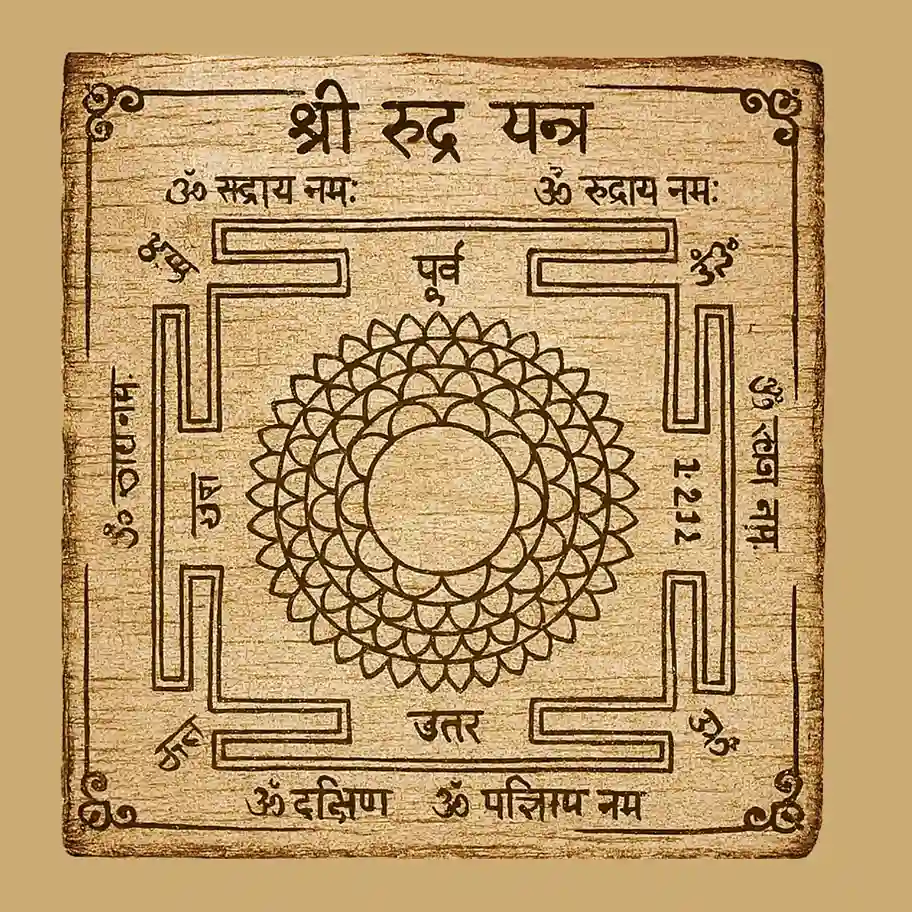
The Rudra Yantra, as depicted in the image, is a sacred geometric embodiment of Shri Rudra-Tattva, drawn with ancient precision upon the Bhojapatra canvas. Each aspect of this yantra is suffused with mantric resonance, tantric symbolism, and spiritual intention, inviting both awe and inquiry. It is not merely a mystical symbol, it is a living mandala of energy, embodying Rudra’s fiery presence and guiding the sādhaka through inner transformation.
The Central Bindu : Parashiva Tattva (Principle) as the Source
At the heart of the yantra rests the Bindu, the primordial point of creation. This dot is not just a geometric center, it is the undivided consciousness, Chaitanya, the transcendental form of Parashiva. It represents the source of all creation, the place where duality ceases and oneness reigns. Gazing upon the bindu during dhyāna leads to stillness, silence, and deep absorption in Rudra’s nirguna state.
Lotus Circles: The Ashta Rudras in Motion
Encircling the bindu is a concentric floral design of tightly knit lotus petals, forming a resonant wheel of vibration and awakening. These petals symbolize the Ashta Rudras, the eight fierce forms of Shiva that govern elemental, karmic, and psychological layers of existence. These deities: Kapali, Pingala, Bhima, Virupaksha, Vilohita, Ajesha, Shasta, Rudra: move through the petals like winds of purification, burning falsehood, igniting tapas, and breaking the illusion of self. The movement of petals is not static, it churns like an inner fire, reflecting the sadhaka’s progression through inner battle and surrender.
The Cardinal Directions: Channels of Shakti
In the space surrounding the inner lotus, one finds inscriptions for Purva (East), Dakshina (South), Paschima (West), and Uttara (North). These directions are not just geographic, they are energetic channels that allow the Shakti to radiate outward and inward. East brings initiation and divine light, South invokes transformation through karma and time, West unfolds introspection and the alchemy of darkness, and North offers ascent into jnana and release. When meditating with the yantra, the sādhaka sits aligned with these energies, drawing their subtle forces into the chakras.
Bhupura: The Sacred Fort of Containment
The outermost frame of the Rudra Yantra is the Bhupura, a square enclosure with four Simha-dvāras or lion-shaped gateways. This structure acts as a protective kshetra, preventing the leakage of energy and anchoring the yantra to the bhu-loka, the earthly dimension. The gateways are not open doors, they are guarded thresholds, requiring purity of sankalpa and inner readiness to cross. As energy flows through these dvāras, it does so in sacred proportion, establishing a balance between containment and expansion.
Directional Mantras: Seed Vibrations of Rudra
In the outer frame are inscribed mantras such as ॐ रुद्राय नमः, ॐ सद्याय नमः, ॐ तेजसे नमः, ॐ कालाय नमः, ॐ दक्षिणाय नमः, and ॐ पश्चिमाय नमः. Each mantra is a bīja-vākya, a seed sentence that invokes a specific manifestation of Rudra aligned with direction and tattva. These mantras act as vibrational guardians, charging the yantra with divine frequencies and making it a potent field for sadhana. Their recitation while meditating on the yantra activates the hidden forces within and establishes a field of protection and purification.
Symbolic and Subjective Depth: Journey from Jiva to Shiva
The yantra as a whole reflects the inner spiritual journey, beginning from the outer gates of fragmented awareness and moving gradually inward through purification, clarity, and eventual union. It is a yantric map of inner tapas, where each ring, each petal, and each mantra pulls the sādhaka deeper into the fire of Rudra. The petals churn karmic impressions, the bindu silences the noise of ego, and the Bhupura holds the field of awakening intact.
Subjectively, this yantra awakens ojas, builds manas-sthairya (mental firmness), strengthens vāk-shakti (power of sacred speech), and instills the courage to walk alone in the fire of truth. It is especially potent for those undergoing inner turmoil, facing fear, or confronting deep karmic residues. For such souls, the Rudra Yantra is a companion of agni, a force that not only burns but also blesses.
In essence, this yantra is not a passive tool of worship but a spiritual weapon, a dynamic mandala of Lord Shiva’s transformative gaze. It is ideal for the aspirant who seeks more than peace, for one who seeks truth, clarity, and liberation through the flame of inner surrender. You may read our article on Navarna Yantra to discover a sacred gateway into the heart of Shakti worship.
Mantras to Activate the Rudra Yantra
The Rudra Yantra is not merely a diagram, it is a tantric pratikā, a subtle instrument of divine energy that must be awakened through the power of sacred sound. This process is known as mantra-samskāra, where specific mantras are chanted to infuse the yantra with divya-prāṇa, or spiritual life-force. Among all mantras available for this purpose, none is more potent or direct than “Om Namo Bhagavate Rudraya”.
This mantra holds the vibration of full surrender, divine invocation, and fierce grace. The syllable Om is the primordial nāda, the original sound from which all creation arises. Namo expresses deep reverence and submission to the higher reality. Bhagavate refers to the One who possesses all six divine attributes, sovereignty, radiance, detachment, wisdom, strength, and beauty. Rudraya calls upon the most intense, transformational form of Shiva, who burns away illusion and fear with a single glance.
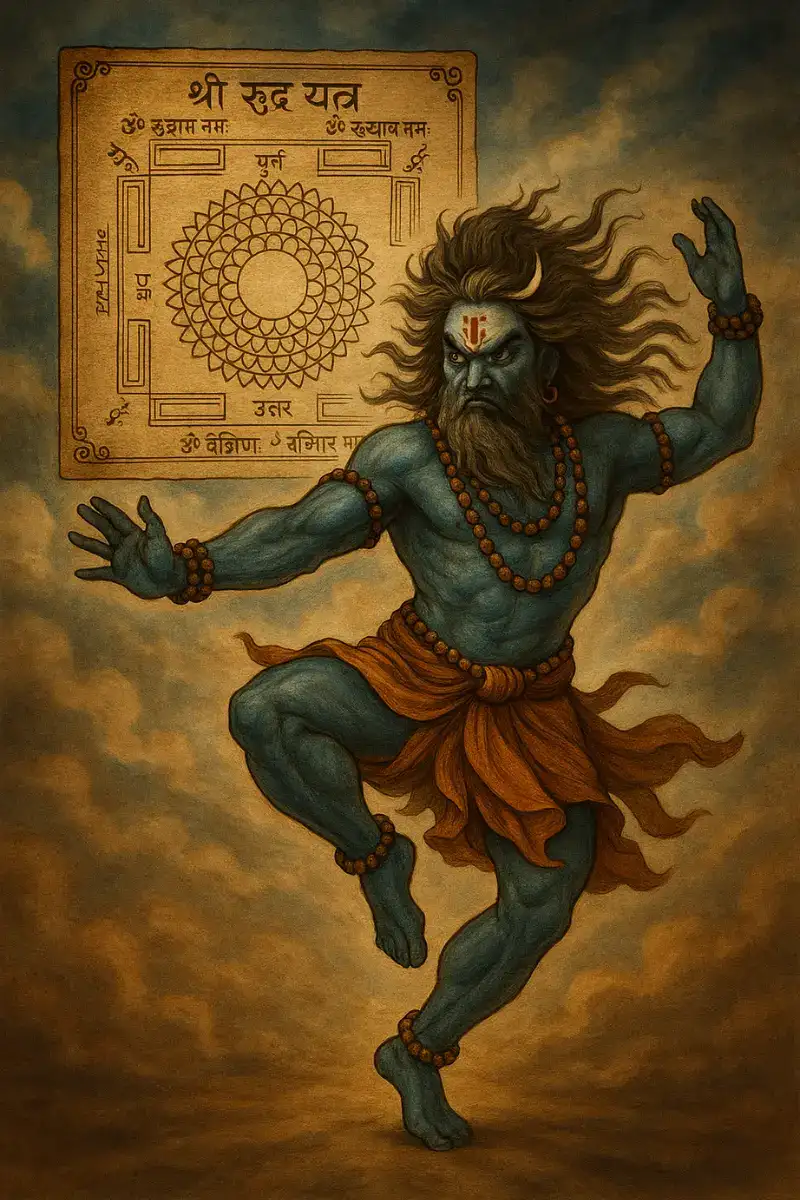
When this mantra is chanted with sincere bhakti and focused awareness, the bindu at the center of the yantra begins to vibrate. This vibration spreads outward through each lotus petal, energizing the entire yantra from its subtle core. The mantra awakens Rudra not only in the geometric form but within the practitioner’s own sūkṣma śarīra, the subtle body. Over time, the yantra no longer remains an external object. It begins to function as a yantra-devatā, a living embodiment of Rudra’s intelligence and power.
To complement this primary mantra, traditional Rudra-focused bīja mantras are also chanted. These include seed syllables like Hraam, Hreem, and Hroum, which carry fiery, protective, and dissolving qualities of Shiva’s energy. When the sādhaka seeks clarity of mind and magnetism in intention, mantras such as Aim and Klim are used. In moments when Rudra’s fierce grace must be supported by the nurturing yet powerful presence of Rudra-Shakti, the mantra “Om Dum Durgayei Namaha” is invoked, anchoring the yantra in divine protection and strength.
For deeper inner activation, the Rudra Gayatri Mantra is employed: “Om Tatpurushaya Vidmahe Mahadevaya Dheemahi Tanno Rudrah Prachodayat.” This is a threefold invocation, meditating upon the Supreme Purusha, contemplating the great Mahadeva, and calling upon Rudra to illumine the inner path. This Gayatri harmonizes the flow of prāṇa through the nāḍīs, purifies inner perception, and expands the flame of inner vision.
However, all mantra recitation reaches its full potency only when the yantra has been blessed and initiated by a Guru through mantra-dīkṣā. Without the Guru’s touch, the yantra remains a dormant form, sacred but asleep. When awakened through initiation, it becomes a jyotirmaya-yantra, alive with light, vibrating with śakti, and responsive to the sādhaka’s spiritual yearning.
In this state, the Rudra Yantra becomes a powerful ally. It purifies karmas, strengthens willpower, dissolves inner confusion, and awakens courage. Through regular japa of “Om Namo Bhagavate Rudraya” in front of the yantra, the devotee does not merely invoke Rudra, they begin to embody him. The yantra becomes the temple, the mantra becomes the key, and the heart becomes the altar where the divine Rudra reveals his presence.
Yantra Preparation Process at YantraChants.com
At yantrachants.com, the Rudra Yantra is not just created, it is invoked into being through sacred discipline, mantra, and the blessings of a living Guru. Every yantra is born from a lineage of devotion, crafted according to āgama-vidhi, and empowered through mantra-samskāra, transforming it from form into living presence.
The yantra is inscribed upon Bhojapatra, a revered medium used since Vedic times to hold divine mantras. Bhojapatra is not just a surface, it is a sattvic, mantra-absorbent bark that has been historically recognized for retaining vibrational resonance. The ink used in the process is made from Aṣṭagandha, a traditional blend of eight sacred aromatic substances, and kumkuma, all carefully mixed using dāru-dālī, handcrafted pomegranate twigs, which are traditionally used as sacred pens for writing mantras. This method ensures that the yantra carries not only visual symmetry but spiritual conductivity.
Each yantra is drawn completely by hand, under the guidance and oversight of the Guru. The lines are formed only when the prāṇa of the practitioner is steady and the manas is absorbed in japa. Every angle, every intersecting triangle, and every petal is measured according to śāstrīya-māna, scriptural proportions laid out in tantra-granthas—ensuring that the yantra becomes a vibrationally exact vessel for Rudra’s presence.
At the very heart of this entire process is the continuous chanting of the Mahamantra, Om Namo Bhagavate Rudrāya. This mantra is the mantra-mūla, the seed-root that calls Sri Rudra from the subtle worlds into the sacred geometry of the yantra. “Om” aligns the sādhaka’s breath with the cosmic pulse. “Namo” bows the ego in surrender. “Bhagavate” praises the divine one who is radiant, complete, and omnipotent. “Rudrāya” invokes the transformative force of Shiva—the destroyer of sorrow and ignorance.
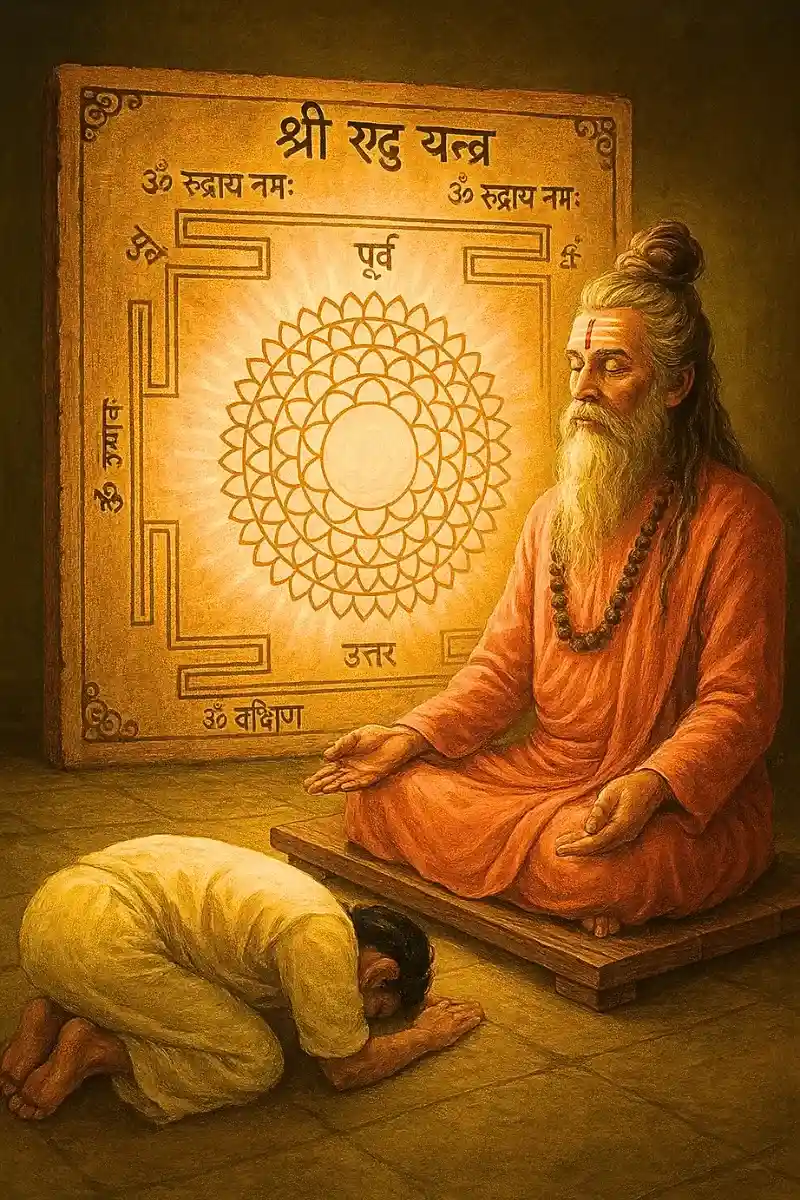
This mantra is chanted not only during the final pūja, but throughout the entire drawing process. From the moment the Bhojapatra is placed on the altar to the final sealing of the yantra with mantra-niyama, the chant of Om Namo Bhagavate Rudrāya continues as an unbroken thread of nāda. It activates the bindu, energizes the lotus petals, and draws the Rudra-tattva inward. This is not mechanical repetition—it is mantra-dhāra, a stream of consciousness poured into every syllable and every line until the yantra becomes alive.
Before being given to the devotee, each Rudra Yantra undergoes prāṇa-pratiṣṭhā, the ritual installation of divine life-force, through a full ṣoḍaśopacāra pūjā conducted by our Guru, Shri Damodar Das Maharaj. The yantra is worshipped as devatā-svarūpa, with sixteen steps of reverence: from avāhana (invocation) and snāna (ritual bathing), to naivedya (offering) and dīpa (light). This process ensures that the yantra is not simply blessed, it is activated as a conscious field of Sri Rudra’s presence.
What makes this process unique is the strength of our Guru Paramparā, rooted in oral transmission, experiential sādhanā, and unbroken faith. At yantrachants.com, the Guru is not only a spiritual teacher but the cakṣuḥ of the devatā, the living eye through which the mantra flows into matter. Every yantra is prepared under his gaze, not merely to fulfill ritual, but to transfer śakti into the hands of the seeker.
Receiving a Rudra Yantra from yantrachants.com is not a transaction, it is a śaktipāta, a descent of divine energy through mantra, Guru, and śraddhā. The yantra becomes your inner guide, your protector during karmic storms, your companion in solitude, and your fire when the world seems dark. Whether your journey is spiritual, worldly, or both, this yantra holds the potency to burn fear, awaken clarity, and summon Rudra’s courage within you.
Sri Guru’s Role in Awakening the Yantra
The yantra, in its most physical form, is a sacred diagram. But without the touch of the Guru, it is like a veena without vibration, a temple without flame. The Guru is not simply a teacher or priest, he is the manifestation of Guru-Tattva, the eternal principle of divine transmission that flows from Lord Shiva himself. When a Rudra Yantra is prepared, it is the Guru who breathes prāṇa into its geometry, transforming it from a symbol into a living spiritual intelligence.
In the tradition upheld at yantrachants.com, the Guru is regarded as an āveśa-mūrti of Lord Rudra. He is not separate from Rudra, but an extension of his anugraha-śakti, the power of divine grace. When Shri Damodar Das Maharaj invokes the yantra through prāṇa-pratiṣṭhā, it is not a mere external ritual, it is an act of śaktipāta, the descent of awakened energy through mantra, glance, and will. The Guru does not simply install energy, he aligns the yantra’s frequency with the exact adhikāra, or inner capacity, of the one who will receive it.
This alignment is essential, especially for those whose lives are surrounded by turbulence, inner fear, or dangerous karmic conditions. There are times when the seeker is vulnerable, lost in tamas, overwhelmed by external situations, or spiritually confused. In such states, the yantra, if unanchored, can remain dormant or even misused. But through the Guru’s touch, even in such fearful or unstable environments, the Rudra Yantra becomes a protective kavacha, a subtle armor infused with icchā-śakti, the intentional will of the Guru to safeguard and empower the seeker.
Only a realized Guru can ensure that the energy of the yantra neither overpowers nor dissipates. Through mantra-japa, dr̥ṣṭi, and internal sankalpa, the Guru customizes the yantra’s activation, regulating the flow of divine force according to what the seeker truly needs, not what the ego desires. The Guru becomes the niyantrakartā, the one who holds the reins of that power, releasing it at the pace that nurtures rather than overwhelms.
The Guru also determines the mantra count (japa-sankhya), the direction of placement (dik-bandha), and the timing of sādhanā (kāla-niyama), ensuring that the yantra functions as an ally in the seeker’s inner journey. He does not just give a yantra, he gives a living upāsya-devatā, one that responds, protects, burns karma, and brings clarity even in the darkest moments.
In truth, the yantra’s power is not just in the mantra inscribed or the geometry drawn, it is in the Guru’s breath, gaze, and sankalpa. The Guru is the agni in the yantra, the silent watcher who ensures that even if the recipient forgets, fears, or falters, the yantra continues to function because it has been sealed with the Guru’s will.
When the Rudra Yantra from yantrachants.com reaches the devotee, it comes as more than a mystical artifact. It comes carrying the presence of the Guru, the fire of Rudra, and the quiet assurance that one is not alone. Even when the world is trembling, even when the mind is scattered, the yantra holds steady, because the Guru has infused it with śakti, smaraṇa, and śaraṇāgati, power, remembrance, and surrender.
In this way, the Guru is the silent force behind every transformation. It is through his grace that the Rudra Yantra becomes not only a tool of protection but a companion of liberation, a flickering light that never goes out, even in the darkest night.
Rare Experiences from Rudra Yantra Worship
When the Rudra Yantra is worshipped with śraddhā (devotional sincerity), niyama (daily discipline), and under the protection of the Guru, subtle transformations begin to unfold, not just externally, but within the sūkṣma sharīra, the subtle body of the sādhaka. These changes are rarely dramatic on the surface but carry deep inner potency. Over time, signs arise, not sought out, but received with quiet awe—revealing that the yantra has begun to awaken its jāgrata rūpa, its living form.
One of the most mysterious yet sacred expressions of this awakening occurs in the realm of svapna-darśana, the dimension of symbolic dreams. Devotees may begin to witness vivid dream-scapes filled with agni (sacred fire), vṛṣaṭkāla (storms or cosmic turbulence), or divya-puruṣas (celestial beings or rishis). These visions are not random, they emerge from the antaḥkaraṇa, the inner instrument of mind and soul, activated through mantra-japa and the yantra’s silent transmission. Sometimes the dream involves standing in fire without being harmed, symbolizing the agni-purification of karmic mala, or the appearance of a radiant ascetic, hinting at śiva-sākṣātkāra, the possibility of inner communion with Rudra Himself.
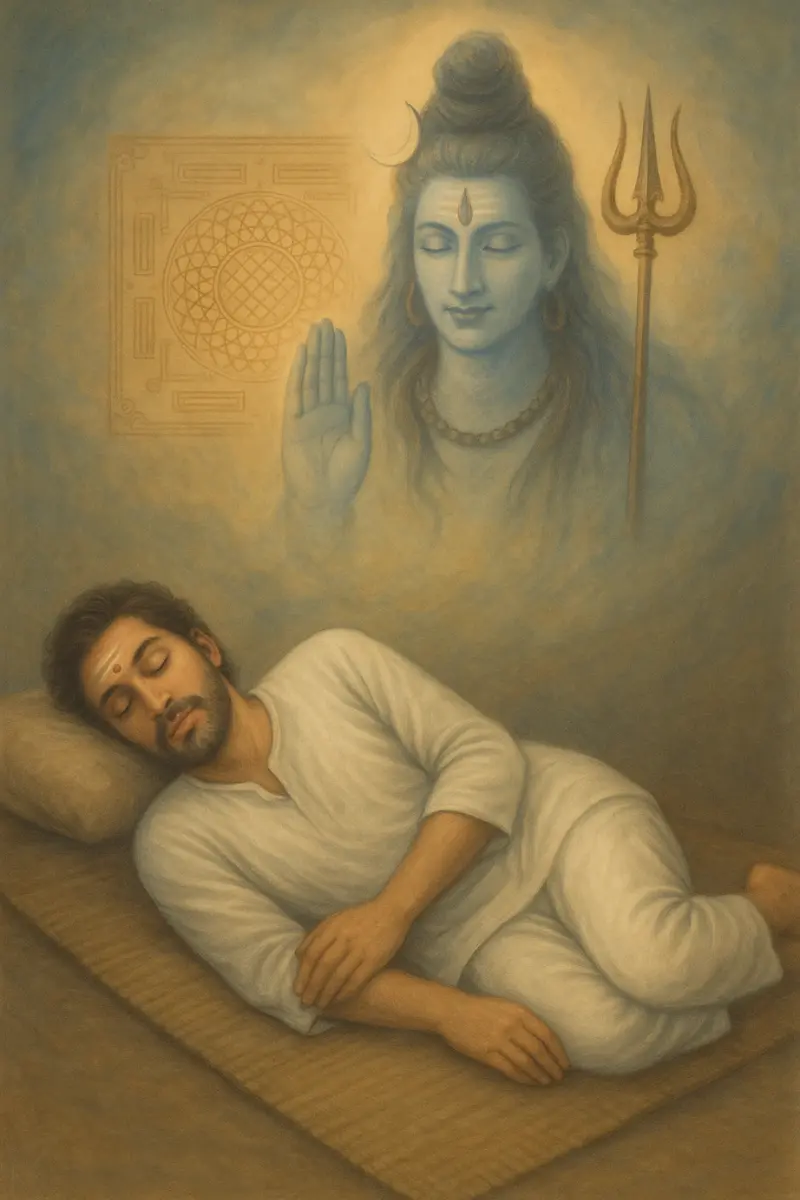
Such dreams serve as svapna-upadeśa, teachings given through the dream-body when the waking mind is still. They may reveal hidden truths, alert the sādhaka of unseen dangers, or offer profound inner reassurance. These dream-experiences can never be mechanically generated, they arise through the anugraha (grace) of the Guru and the yantra working together as subtle guides.
Apart from dreams, many sādhakas report spontaneous mantric chanting from within, as though mantra-ucchāraṇa begins on its own, especially near the yantra. At times, during Shivaratri, Pradosha, or tithis aligned with Rudra’s tattva, the yantra’s energy becomes palpably radiant. It may emit subtle warmth, or the practitioner may feel uṣṇatā (heat) in the palms when offering puṣpa (flowers) or performing dhyāna in its presence. This is not a physical reaction alone, it reflects tāpa-traya kṣaya, the burning away of the threefold karmic burdens through direct energetic contact.
The Rudra Yantra often begins to intervene silently in dharma-kṣetra, the battlefield of life. Some devotees receive sudden clarity in dilemmas that once seemed entangled. Others find themselves instinctively making the right choice, as if guided by an unseen hand. There are cases where legal disputes, adversarial energies, or intergenerational karmic burdens begin to resolve, not necessarily through miraculous escape, but through inner realignment and ṛta-pravṛtti, a shift toward cosmic order.
Health afflictions tied to pitr̥-doṣa, ṛṇa-bandhana, or past life karmas may also soften under its influence, especially when worship is supported by nitya-japa, abhisheka, and the Guru’s protective intent. The yantra acts like a karmic absorber, holding the weight that the sādhaka may not yet be ready to carry. It becomes a rakṣa-kavacha, not just externally, but in the deepest recesses of the emotional and psychic body.
In the advanced stages of worship, some sādhakas may feel an invisible presence during japa, as though seated with a silent witness. Others have described moments of antaḥ-sphuraṇa, spontaneous inner radiance or stillness, where time seems to stop and fear dissolves. These are moments of rudra-prasāda, the grace that comes not from effort, but from the intimate touch of the devatā through the yantra’s awakened geometry.
At yantrachants.com, these rare experiences are not seen as supernatural, they are understood as natural signs of alignment between the devotee, the devatā, and the Guru. The Rudra Yantra, when prepared through Guru-kr̥pā and worshipped through śuddha-bhāva, becomes more than a spiritual tool. It becomes a sākṣāt-sahacara, a living companion on the soul’s journey through karma, fear, and ultimately, liberation.
How to Chant the Shiva Mantra
Since it is Lord Shiva’s mantra, during Sadhana, eat vegetarian food and maintain celibacy. You can wake up at any time before 7:30 am. It is most auspicious to start chanting the mantra from a Shivaratri day.
In your pooja room, take a bath, wear clean clothes and sit on a woollen mat. On the altar keep an idol or photo of Lord Shiva. Just close your eyes and meditate on the form
of Rudra. You can take a subtler form of Lord Shiva as well. Think about Lord Shiva and take a sankalpa of chanting the mantra for 7, 21 or 41 days without missing a single day.
Express your desire and start chanting. Beginners can chant of 4 rounds of this mantra. While chanting, imagine a slate and you are writing the mantra ‘Om Namo Bhagavate Rudraya’ on it. Practice this meditation until the mantra flows naturally. During this phase of deeper connection, you may also wish to recite namah somaya cha rudraya cha, an invocation from the Yajurveda that beautifully balances Shiva’s peaceful and fierce energies. While the Rudra mantra awakens intensity, this Vedic phrase helps integrate calmness and compassion—completing the sadhana experience.
For beginners, this process might seem intimidating. Naturally you will face a lot of distractions. Simply bring your mind back to the slate and continue writing.
You may be taken away by some thought and would not realize how time flew. This is not effective chanting. Increase your will-power by slowly and gradually increasing the time for sadhana. This is a very powerful technique to obtain perfection very soon. The invocation om rudraye namah should be mentally chanted at the start and end of every session. It anchors your practice, helping maintain continuity across days. This salutation also invokes Rudra’s subtler grace—the kind that comes not with fireworks, but with inner stillness and lasting clarity.
The Om rudraya namah meaning in this context means “I bow down to Rudra,” the fierce and compassionate energy of Lord Shiva that dissolves pain and ego.
For advanced seekers, understanding the om vachat bhuve namah benefits in english reveals a more cosmic aspect of Rudra worship. This phrase praises the energy of speech and the creative vibration of sound. When recited correctly, it activates the power of divine articulation, essential for mantra siddhi and eloquent self-expression in spiritual dialogue.
Invite Lord Rudra’s fierce grace into your life. Request your energized yantra to burn away inner fear and restore strength.
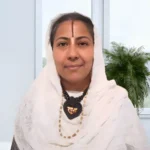
Rohini Devi Dasi

